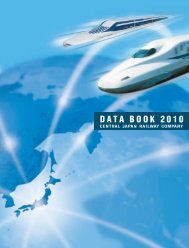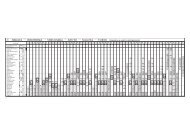CENTRAL JAPAN RAILWAY COMPANY Annual Report 2007
CENTRAL JAPAN RAILWAY COMPANY Annual Report 2007
CENTRAL JAPAN RAILWAY COMPANY Annual Report 2007
You also want an ePaper? Increase the reach of your titles
YUMPU automatically turns print PDFs into web optimized ePapers that Google loves.
Developing New Earthquake Resistant Construction Methods<br />
It is characteristic that stores and offices exist below the elevated tracks of the Tokaido<br />
Shinkansen since the Tokaido Shinkansen travels through the densely populated area of<br />
Tokyo and Osaka. In order to engage in construction in these areas we strived to develop<br />
new earthquake reinforcement construction methods. As a result, we co-developed “steel<br />
panel assembly reinforcement construction methods” and “damper brace construction<br />
methods” with related companies. Since these methods are superior in practice they are<br />
being applied to elevated track columns that exist within stores around stations.<br />
Discovery of a New Technology to manufacture “Metal-Oxide Thin Film”<br />
In the course of researching photo catalysts as part of our “challenging new fields”, we<br />
discovered a new technology to manufacture at low cost and high quality “metal-oxide<br />
thin film” that is widely used in thin displays and touch panel displays, which are in high<br />
demand as of late, and solar cells.<br />
Since this new technology has great versatility because it enables the manufacture of<br />
various metal and allow mixture oxide thin film, it can be applied to a wide variety of<br />
fields.<br />
We are continuing development aimed at practical use.<br />
Steel Panel Assembly Reinforcement Method<br />
Success in Development of Superconducting Electromagnets that utilize<br />
MgB2 (Magnesium Diboride)<br />
In cooperation with Hitachi, Ltd., JR Central has co-developed a superconducting coil<br />
(500mm in diameter) larger than conventional coils by employing MgB2 superconducting<br />
wire which has gained much attention as of late as a new metal superconducting<br />
material. Using this coil, we succeeded in conducting the world’s first test that makes it<br />
function as a superconducting magnet that uses the conduction cooling method that<br />
employs a freezer without requiring liquid coolant like liquid helium.<br />
As a result of this test, we were able to prove that MgB2 superconducting wire can be<br />
applied to practical systems and we are continuing research and development that aims<br />
to enlarge the size of the coil and to produce a higher magnetic field. By continuing this<br />
research and development, we expect to be able to apply the technology to<br />
superconducting fly wheels, MRI medical diagnosis equipment and so on.<br />
Production Technology for Metal Oxide Thin Film<br />
Conventional manufacturing<br />
process<br />
(complicated and high cost)<br />
Process employing new technology<br />
(simple and low cost)<br />
Overview of the Superconducting Coil Testing Device<br />
Substrate<br />
Pressure reduction<br />
of apparatus interior<br />
Plasma generation<br />
High-vacuum<br />
medium<br />
Raw material<br />
Plasma<br />
Special metal<br />
complex solution<br />
Coating<br />
Coating apparatus<br />
Deposition<br />
on substrate<br />
Calcination<br />
Formation of metal<br />
oxide thin film<br />
Substrate<br />
Sputtering equipment<br />
(several billion yen)<br />
Formation of metal<br />
oxide thin film<br />
cost reduction in billions of yen<br />
Kiln (electric furnace)<br />
several tens of million of yen)<br />
21





